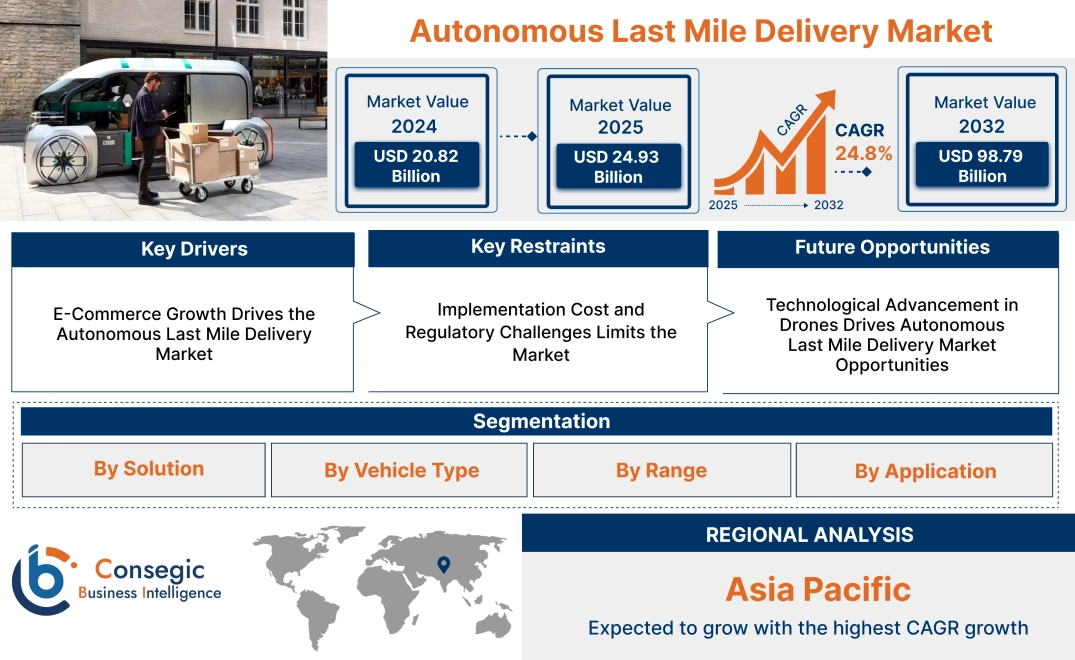Autonomous Last Mile Delivery Market Size:
Autonomous Last Mile Delivery Market Size is estimated to reach over USD 98.79 Billion by 2032 from a value of USD 20.82 Billion in 2024 and is projected to grow by USD 24.93 Billion in 2025, growing at a CAGR of 24.8% from 2025 to 2032.
Autonomous Last Mile Delivery Market Scope & Overview:
Autonomous last-mile delivery is a technology that involves using self-operating vehicles, such as drones and robots for transporting goods from a distribution hub to the final customer's location. The benefits of autonomous delivery including faster deliveries, cost saving, route optimization, reduced emissions and improved customer experience among others are driving the market. Moreover, the services are used for a wide range of applications in logistics, food and beverage, retail, and others which in turn drive the market. Further key trends driving the market include the growing adoption of AI and machine learning for optimized routing and real-time delivery management. Furthermore, the increasing focus on sustainable delivery solutions by utilizing electric and hybrid autonomous vehicles is driving the market.
How is AI Impacting the Autonomous Last Mile Delivery Market?
AI is significantly impacting the autonomous last mile delivery market by enhancing efficiency, reducing costs, and improving customer experience. AI-powered solutions optimize routes, predict demand, automate processes, and enable autonomous vehicles such as drones and self-driving cars. This leads to faster, more reliable, and cost-effective deliveries, while also contributing to sustainability efforts. Also, AI algorithms analyze various factors like traffic, weather, and delivery locations to determine the most efficient routes, minimizing travel time and fuel consumption. Further, AI predicts future demand based on historical data and market trends, allowing businesses to optimize inventory and delivery schedules, reducing overstocking or stockouts.
Autonomous Last Mile Delivery Market Dynamics - (DRO):
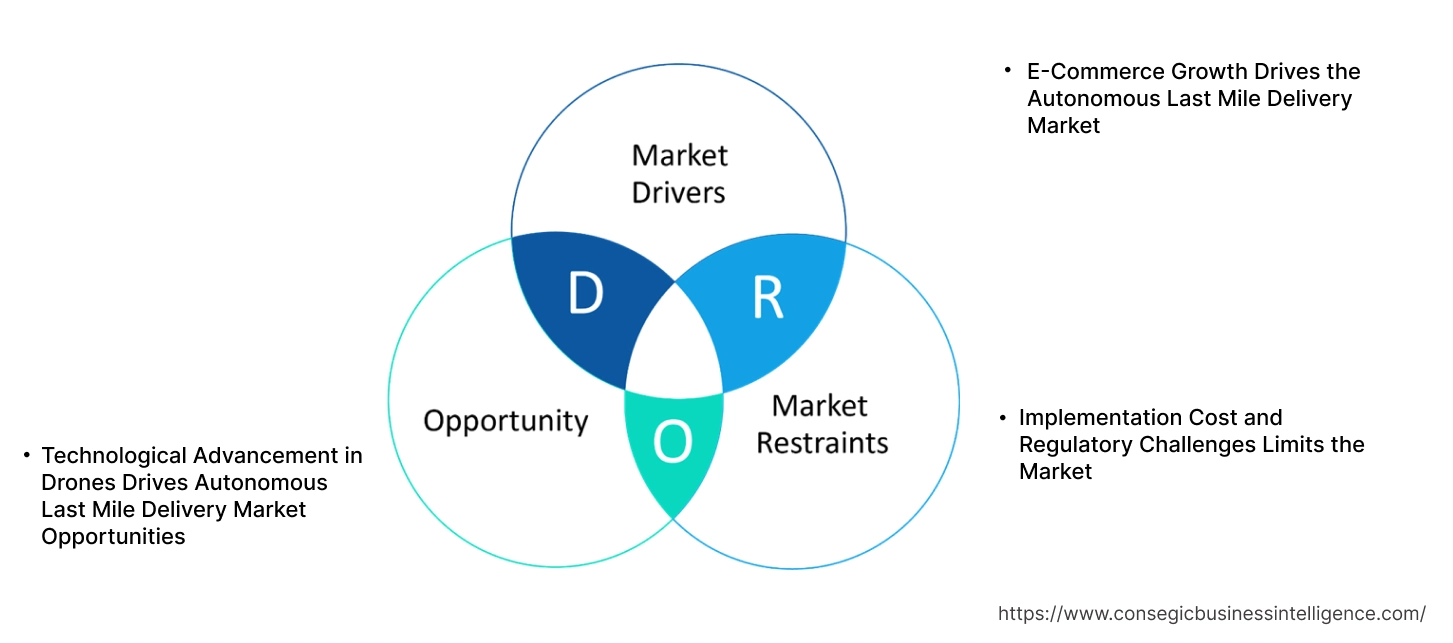
Key Drivers:
E-Commerce Growth Drives the Autonomous Last Mile Delivery Market
The rapid growth of e-commerce has fundamentally reshaped consumer expectations for an exceptional demand for rapid and efficient delivery services. The surge in online shopping has placed immense pressure on conventional last-mile delivery systems, encouraging businesses to seek innovative solutions. Autonomous last-mile delivery, utilizes technologies such as drones and delivery robots for enhancing customer experience. The automation of the final stage of delivery is helping companies to mitigate the logistical complexities and costs associated with reaching individual customers, ultimately enhancing customer satisfaction and streamlining operations.
- For instance, according to International Trade Administration (U.S. Department of Commerce) Global B2C e-commerce market size is expected to reach USD 5.5 Trillion by 2027, growing at a CAGR of 14.4%.
Thus, rising disposable income, urbanization, technological advancements are driving e-commerce sector which in turn drives the autonomous last mile delivery market size.
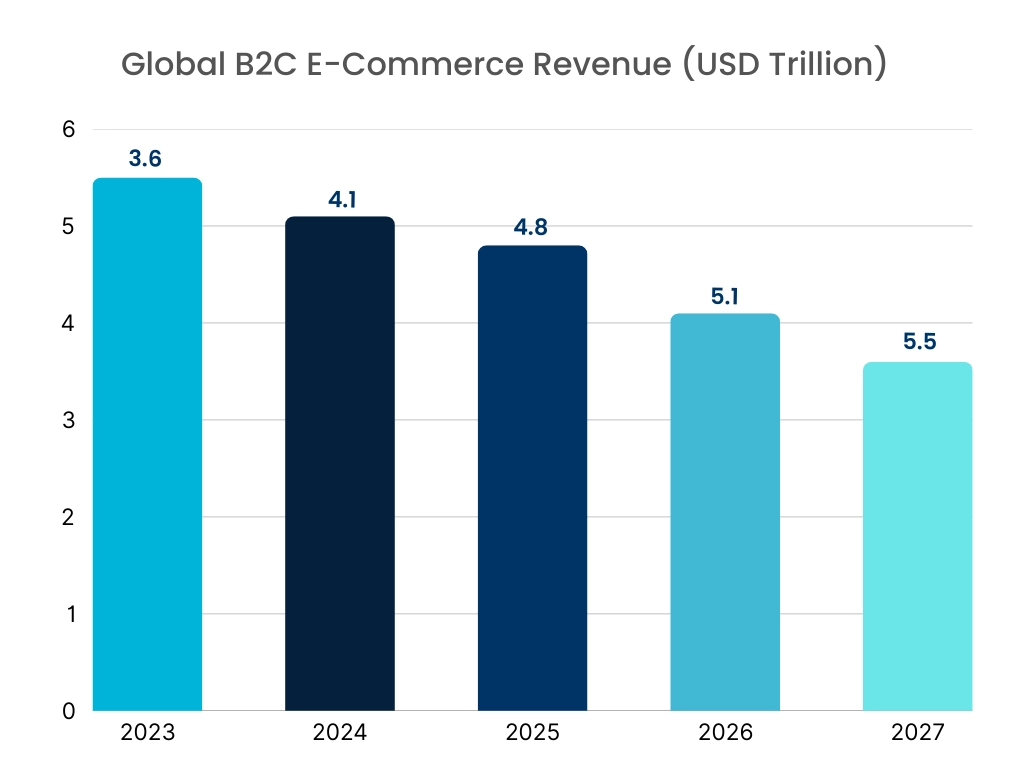
Key Restraints:
Implementation Cost and Regulatory Challenges Limits the Market
The widespread adoption of autonomous last-mile delivery faces significant hurdles due to substantial implementation costs. The development and deploying fleets of autonomous vehicles require significant investment in hardware, software, and infrastructure. Further, navigating the complex and evolving regulatory landscape poses a major challenge. The operation of autonomous delivery services requires necessary permits and approvals, particularly in densely populated areas, which can be a lengthy and uncertain process. Additionally, varied regulations across different regions and countries further complicate the market, hindering scalability and standardization. Thus, the aforementioned factors collectively create a restrictive environment, limiting the immediate expansion and commercial viability of autonomous last mile delivery solutions.
Future Opportunities:
Technological Advancement in Drones Drives Autonomous Last Mile Delivery Market Opportunities
The increasing technological advancements in drone technology are significantly expanding the opportunities within the autonomous last-mile delivery market. There have been significant improvements in battery life, navigation systems, and payload capacity which is making drone delivery increasingly viable for commercial applications. Further, enhanced sensor technology allows for precise obstacle avoidance and safe operation in complex urban environments.
Furthermore, the development of sophisticated software and AI algorithms enables autonomous flight and package handling, minimizing human intervention. The aforementioned advancements are improving the efficiency and speed of deliveries and thereby reducing the overall operational costs. Thus, technological advancement such improvement in battery life and payload capacity and integration of sensors drives the autonomous last mile delivery market opportunities.
Autonomous Last Mile Delivery Market Segmental Analysis :
By Solution:
Based on the solution, the market is segmented into hardware, software, and services.
Trends in the Solution:
- Increasing use of lightweight and durable materials to improve fuel efficiency and payload capacity is driving the autonomous last mile delivery market trend.
- Growing use of fleet management software for monitoring and controlling the large fleets of autonomous delivery vehicles is expected to drive autonomous last mile delivery market size.
Hardware accounted for the largest revenue share of 48.42% in the year 2024.
- Increasing integration of advanced sensors including LiDAR sensors, radar sensors, and others for precise navigation and obstacle avoidance is driving the autonomous last mile delivery market share.
- Further, technological advancement in battery technology is driving drones and ground robots which in turn drives the market.
- Furthermore, fast-charging and energy-efficient hardware is driving the market of autonomous last mile delivery.
- Thus, as per autonomous last mile delivery market analysis, integration of advanced sensors, improvement in battery technologies, and focus on energy efficiency is driving the market.
Service is anticipated to register the fastest CAGR during the forecast period.
- Growing need of autonomous services for analyzing delivery data and optimizing operations in turn driving the autonomous last mile delivery market share.
- Further, growing focus on cybersecurity to protect autonomous delivery systems from data breaches is expected to drive the autonomous last mile delivery market demand.
- Furthermore, growing need for maintenance and repair services is further driving the market.
- Therefore, based on analysis, cybersecurity enhancement, data analytics & optimization services, and maintenance & repair services is anticipated to boost the market during the forecast period.
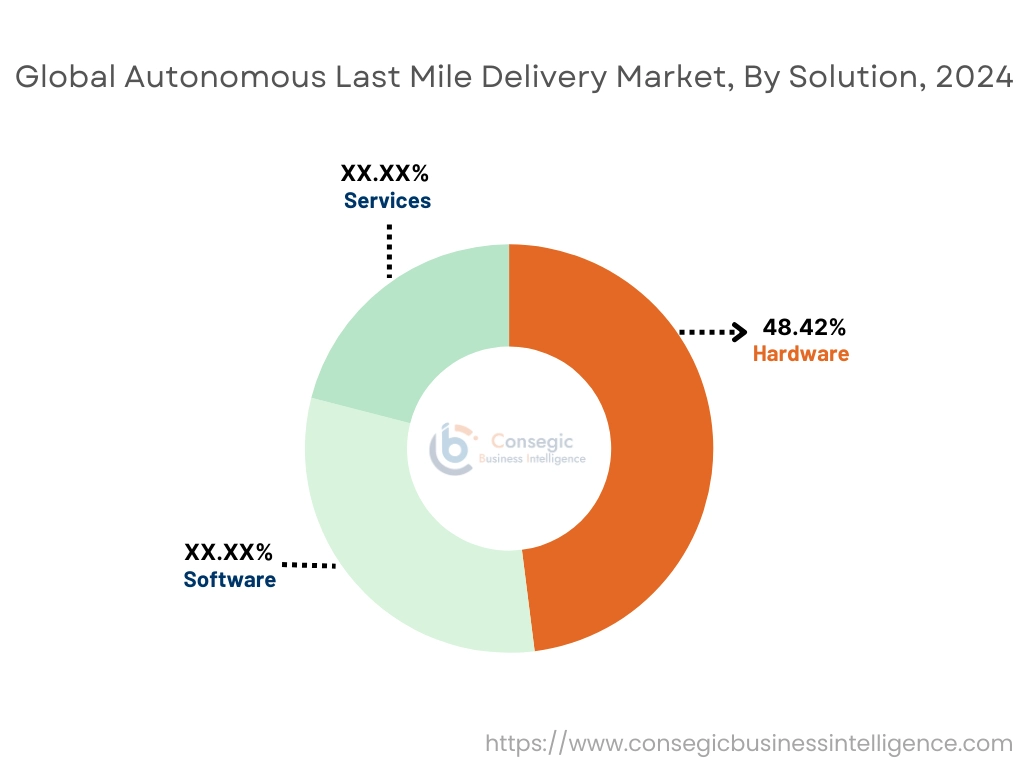
By Vehicle Type:
Based on the vehicle type, the market is segmented into ground delivery vehicles and aerial delivery drones.
Trends in the Vehicle Type:
- The growing use of GPS, computer vision, and AI to navigate and avoid obstacles is driving the autonomous last mile delivery market demand.
- Increasing focus on regulatory compliance and safety is driving during the forecast period.
Ground delivery vehicles accounted for the largest revenue share in the year 2024.
- Growing use of delivery bots in urban environments for delivering packages directly to consumers' doorsteps is boosting the market.
- Further, growing advancements in AI and sensor technology for improving the ability of ground delivery vehicles to navigate and avoid obstacles is driving the autonomous last mile delivery industry.
- Furthermore, growing focus on electric and sustainable solutions is driving the autonomous vehicle demand.
- For instance, For instance, Continental AG and Aurora are collaborating to develop a scalable autonomous truck system, aiming for production by 2027. This system, involving both hardware and software, is being tested on US highways with major truck manufacturers like Peterbilt.
- Thus, as per autonomous last mile delivery market analysis, adoption in urban environment, enhanced navigation, and focus on sustainability are driving the market.
Aerial delivery drones are anticipated to register the fastest CAGR during the forecast period.
- The rise of e-commerce in emerging economies fuels the need for aerial delivery drones, which subsequently propels the market.
- Further, technological advancement in range and payload capacity of a drone is a key factor in the rise of the autonomous last mile delivery market trends.
- Therefore, rise of e-commerce and technological advancement is anticipated to boost the market during the forecast period.
By Range:
Based on the range, the market is segmented into short range and long range.
Trends in the Range:
- Increasing advancement in electric autonomous trucks and vans for last mile delivery drives the autonomous last mile delivery market expansion.
- Increasing focus on eco-friendly and sustainable solutions to minimize carbon footprints is driving the market.
Short Range accounted for the largest revenue share in the year 2024.
- Growing deployment of ground delivery robots in urban areas, particularly for food and small package delivery drives the market.
- Further, increasing adoption of drone deliveries in urban and densely populated environments is driving the market.
- Furthermore, growing use of AI for autonomous delivery in busy areas such as streets and shopping centers is driving the autonomous last mile delivery market growth.
- Thus, based on analysis, advancements in combustion strategies, growing trend of automation of autonomous vehicles, fuel efficiency, and advanced software control are driving the market.
Long range is anticipated to register the fastest CAGR during the forecast period.
- The adoption of drone delivery in rural and remote areas propels the autonomous last mile delivery market expansion.
- Further, technological advancement in long-range drone delivery is a key factor in the growth of the market.
- Furthermore, development of long-range electric autonomous trucks is accelerating market growth.
- Therefore, based on analysis, growing adoption of drone delivery, technological advancement, electric autonomous trucking of e-commerce and last-mile delivery services is anticipated to boost the market during the forecast period.
By Application:
Based on the application, the market is segmented into logistics, healthcare and pharmaceutical, food and beverage, retail, and others.
Trends in the Application:
- Rising use of autonomous drones for delivering the time-sensitive medications, blood samples, and others to hospitals and clinics which in turn drives the market.
- Increasing use of data analytics and AI to optimize logistics operations, including route planning, delivery scheduling, and inventory management which in turn drives the market.
Retail accounted for the largest revenue share in the year 2024.
- The growing focus on sustainability and increasing use of AI and automation is driving the retail industry, which in turn drives the market.
- Further, retailers are using data analytics to personalize the delivery experience for customers which drives the delivery services market.
- Furthermore, growing trend of same day delivery is resulting in the development of drone sector which in turn drives autonomous last mile delivery market.
- Thus, based on analysis, focus on sustainability, same day delivery, and personalized delivery experiences is driving the market.
Food and beverage is anticipated to register the fastest CAGR during the forecast period.
- The changing lifestyle, rapid urbanization, and growing disposable income is driving the food and beverage industry which subsequently propels the autonomous last mile delivery market.
- Further, increased use of drones for food and beverage delivery especially for smaller and lighter packages, is a key factor in the growth of the autonomous last mile delivery market trends.
- For instance, Flytrex Inc. is a key player in US market specializing in on-demand drone delivery services, focusing on delivering food and retail items directly to customers'.
- Therefore, based on analysis, aforementioned factors are anticipated to boost the growth of the market during the forecast period.
Regional Analysis:
The regions covered are North America, Europe, Asia Pacific, Middle East and Africa, and Latin America.
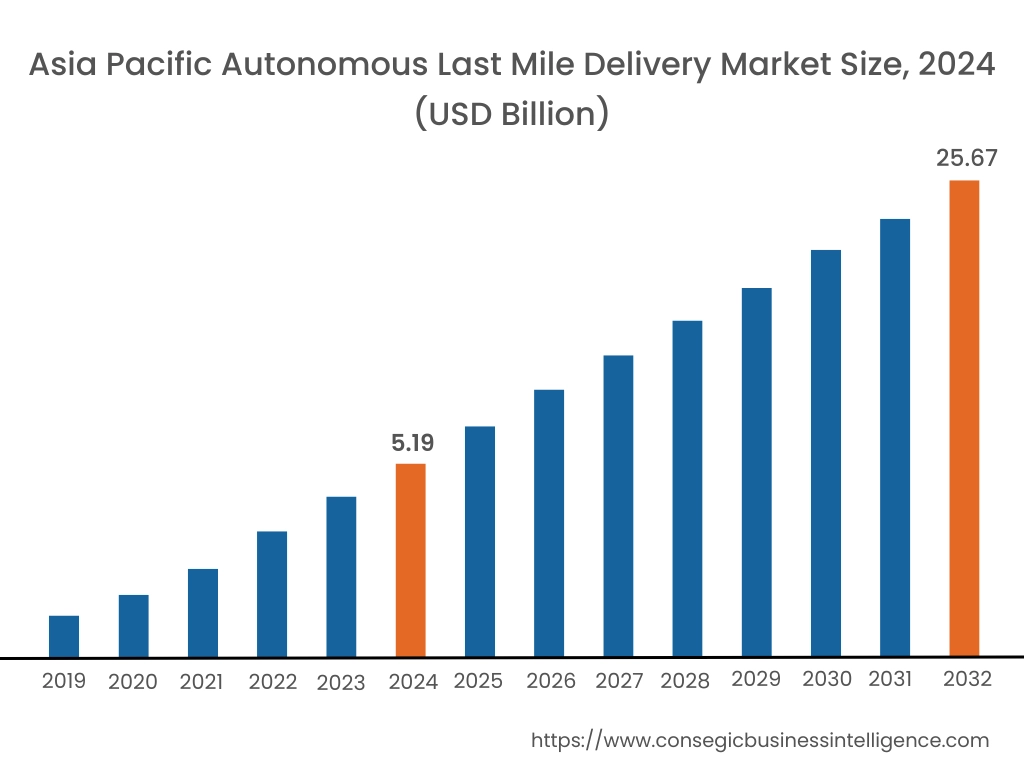
Asia Pacific region was valued at USD 5.19 Billion in 2024. Moreover, it is projected to grow by USD 6.24 Billion in 2025 and reach over USD 25.67 Billion by 2032. Out of this, China accounted for the maximum revenue share of 38.53%. The market for autonomous last mile delivery is mainly driven by rapidly growing e-commerce sector and increasing demand for efficient delivery solutions. Furthermore, technological advancements and rising consumer expectations for fast and convenient delivery options are significantly fueling the market.
- For instance, TSAW Drones based in India introduced delivery drone MARUTHIGeneration with a payload carrying capacity of 20kg and flight range of 40km.
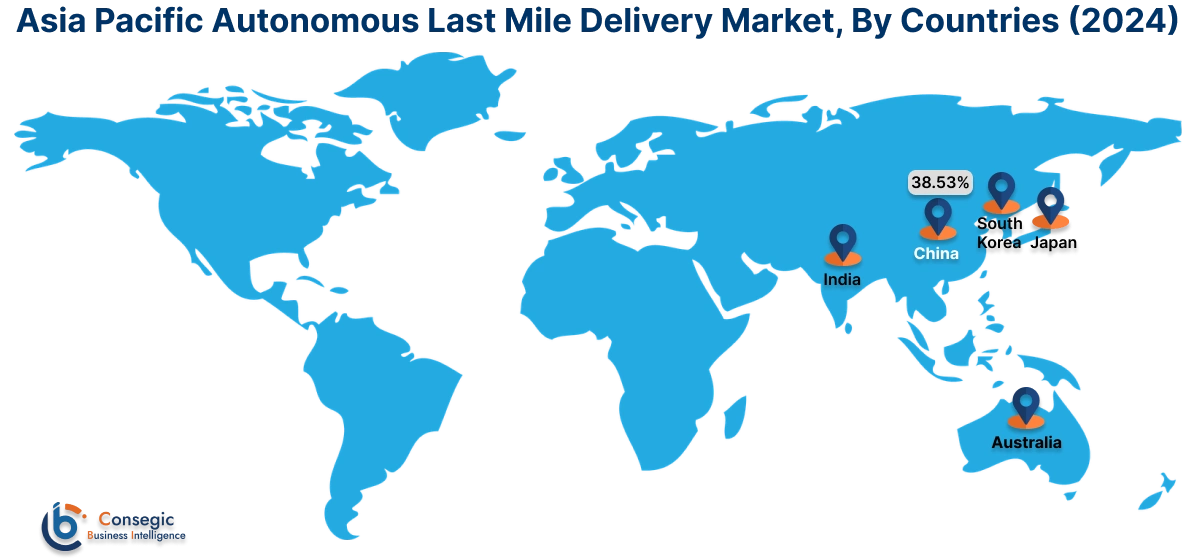
North America is estimated to reach over USD 35.05 Billion by 2032 from a value of USD 7.31 Billion in 2024 and is projected to grow by USD 8.76 Billion in 2025. The North American market is primarily driven by advanced technological infrastructure and the high demand for efficient e-commerce delivery. Furthermore, the increasing labor costs in the logistics sector and a strong emphasis on innovative solutions, is accelerating the adoption of autonomous delivery technologies.
- For instance, in August 2024, A2Z Drone Delivery introduced a new system featuring autonomous drone docks and a compatible UAV which enables drones to automatically recharge and transfer packages between docks. The company offers both single and multi-drone dock options, facilitating versatile and scalable drone delivery networks.
The regional analysis depicts that strong focus on sustainable logistics and the increasing adoption of drones for delivery in Europe is driving the market. Additionally, the factors driving the market in the Middle East and African region are increasing growing adoption of e-commerce, rising disposable income, and rapid urbanization. Further, growing development in logistic infrastructure, increasing economic activities and rise in disposable incomes is paving the way for the progress of market in Latin America region.
Top Key Players & Market Share Insights:
The global autonomous last mile delivery market is highly competitive with major players providing solutions to the national and international markets. Key players are adopting several strategies in research and development (R&D), product innovation, and end-user launches to hold a strong position in the Autonomous Last Mile Delivery industry. Key players in the global Autonomous Last Mile Delivery market include-
- A2Z Drone Delivery, LLC (US)
- Flytrex Inc. (Israel)
- Starship Technologies (US)
- TeleRetail (Switzerland)
- Nuro, Inc. (US)
- Kiwibot (US)
- Wing Aviation LLC (US)
- com, Inc. (China)
- Alibaba Group Holding Ltd. (China)
- Amazon, Inc. (US)
- Udelv Inc. (US)
- Drone Delivery Canada Corp. (Canada)
Recent Industry Developments :
Product Launch:
- In November 2024, Amazon Prime Air introduced its new, quieter, and longer-range MK30 delivery drone in Arizona and Texas, designed with aerospace-level reliability to deliver packages up to five pounds within an hour.
- In July 2024, A2Z Drone Delivery upgraded its RDSX Pelican drone with an open-source flight controller, facilitating easier integration with custom payloads and software. This move is a step towards the company's goal of manufacturing the Pelican in the US, aiming to provide customers with greater flexibility and customization options.
Autonomous Last Mile Delivery Market Report Insights:
| Report Attributes | Report Details |
| Study Timeline | 2019-2032 |
| Market Size in 2032 | USD 98.79 Billion |
| CAGR (2025-2032) | 24.8% |
| By Solution |
|
| By Vehicle Type |
|
| By Range |
|
| By Application |
|
| By Region |
|
| Key Players |
|
| North America | U.S. Canada Mexico |
| Europe | U.K. Germany France Spain Italy Russia Benelux Rest of Europe |
| APAC | China South Korea Japan India Australia ASEAN Rest of Asia-Pacific |
| Middle East and Africa | GCC Turkey South Africa Rest of MEA |
| LATAM | Brazil Argentina Chile Rest of LATAM |
| Report Coverage |
|
Key Questions Answered in the Report
How big is the autonomous last mile delivery market? +
The autonomous last mile delivery market is estimated to reach over USD 98.79 Billion by 2032 from a value of USD 20.82 Billion in 2024 and is projected to grow by USD 24.93 Billion in 2025, growing at a CAGR of 24.8% from 2025 to 2032.
What specific segmentation details are covered in the autonomous last mile delivery report? +
The autonomous last mile delivery report includes specific segmentation details for solution, vehicle type, range, application, and regions.
Which is the fastest segment anticipated to impact the market growth? +
In the autonomous last mile delivery market, long range is the fastest-growing segment during the forecast period.
Who are the major players in the autonomous last mile delivery market? +
The key participants in the autonomous last mile delivery market are A2Z Drone Delivery, LLC (US), Flytrex Inc. (Israel), Wing Aviation LLC (US), JD.com, Inc. (China), Alibaba Group Holding Ltd. (China), Amazon, Inc. (US), Udelv Inc. (US), Drone Delivery Canada Corp. (Canada), Starship Technologies (US), TeleRetail (Switzerland), Nuro, Inc. (US), Kiwibot (US) and others.
What are the key trends in the autonomous last mile delivery market? +
The autonomous last mile delivery market is being shaped by several key trends including increasing demand for faster, more efficient delivery solutions driven by the e-commerce boom, and by the rapid advancements in technologies like AI and robotics.
